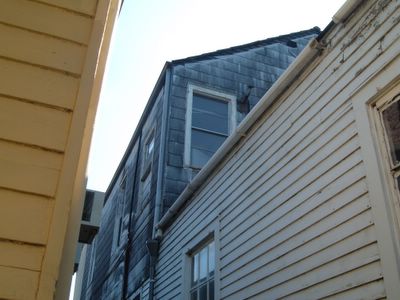NEW ORLEANS PHOTOBLOGGING (Part Five)
Continuing the series of pictures I took in New Orleans last May. (Part 1, Part 2, Part 3, Part 4).
As I've said before, the French Quarter is a work of exquisite beauty, and it's beauty goes beyond that which was intended. The closed quarters of the neighborhood, it's narrow streets and alleyways, all make for an angular, abstract-expressionist orgy of weird geometric shapes and colors wherever you look. Like this view right outside our guest room:
Of course, that's just a cool by-product of the architectural landscape. The architecture itself is also beautiful, not to mention old. Many of the buildings date back to Spain's brief colonial control of the Louisiana territory at the end of the eighteenth century--most of the preexisting French structures were destroyed by a couple of major fires; even though the Spaniards managed to clean up a great deal of political corruption in the Crescent City, fire fighting was apparently not one of their strong suits.
But, hey, check out this old and cool chimney and bay window:
If you look closely at the chimney, you'll notice gray patches of masonry where it has seemingly been repaired numerous times over the years. I don't think the above picture is an example of the Spanish architecture style I was talking about a moment ago: it seems Victorian, so my bet is that this rooftop dates to sometime in the mid-nineteenth century, when many other buildings in the Quarter were built; by this time New Orleans had become thoroughly Americanized, although I understand one could still hear French being spoken in Vieux Carre as late as the early twentieth century.
Anyway, back to the Spanish influence. One of the most distinctive characteristics of the Quarter is its abundance of wrought iron.
From iNeTours:
Prior to the industrial age, blacksmiths worked with wrought iron, made and refined in charcoal fires. Charcoal iron can withstand corrosion for hundreds of years as evidenced by many a two hundred year old French Quarter balcony.
Traditional decorative ironwork is not easy to maintain. Repousse—shaped or decorated with patterns in relief formed by hammering and pressing on the reverse side—is often difficult to paint.
Once mild steel was introduced with its ability to be mass produced, wrought iron, and the craft skills associated with it, gradually disappeared. Most of the ironwork in the French Quarter is actually cast iron and dates to the 1850's when this type of adornment became wildly popular.
Click here for the rest.
Ahhhh...so it's not wrought iron at all! It's actually cast iron. Like my grandma's skillet that I still use to fry catfish. I guess you learn something everyday. The cast iron of New Orleans is, like the architicture, quite beautiful as well, but, also like the architecture, tends to create an aesthetically pleasing by-product. Like these cool shadows on the sidewalk:
Speaking of sidewalks, here's another shot looking down my favorite French Quarter street, Decatur:
Note the gay oriented Rainbow Flag flown proudly beside the US Flag. New Orleans is a center of gay culture, and the French Quarter is to New Orleans what the Castro is to San Francisco, the Village is to New York, and Montrose is to Houston. That is, the Quarter is pretty gay. Not that there's anything wrong with that. In fact, it's pretty cool. New Orleans, as a post WWII port city, had one of the earliest gay communities in America--apparently, gay service men and women who had met during the war decided in droves to stay in the more sophisticated coastal port cities rather than return to their repressive home towns. Evidence of the New Orleans gay scene is all around the French Quarter. Like this nighttime neon-lit storefront window display of Ken dolls in gay regalia:
All this gay talk somehow makes this last photo fitting:
This shot is looking up into a mimosa tree somewhere in the Quarter. It's fitting because "mimosa" is also the name of a fruity drink. Get it? Fruity? Ah, never mind. Interestingly, the mimosa tree, which seems to be all over Louisiana - there's one in our next door neighbor's front yard, in fact - isn't actually its real name. Apparently, it's real name is albizia, and is mistakenly called "mimosa" because of its resemblance to a shrub of the same name. Personally, I prefer the name "mimosa;" it's delicate sounding. The tree's weird pink flowers don't really look like what I think of when I hear the word "albizia." Actually, I don't really know what I think of when I hear the word "albizia." Eastern Europe, maybe.
More New Orleans photoblogging to come...
$$$$$$$$$$$$$$$$$$$$$$$$$$$$$$$
Saturday, July 23, 2005
Posted by Ron at 10:59 PM
Subscribe to:
Comment Feed (RSS)
















|